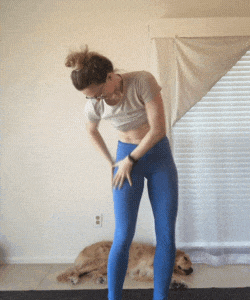Building Visual and Physical Awareness for Square Splits
Building Visual and Physical Awareness for Square Splits
I’ve written before about why we often care so much about keeping our hips “square” (both hip bones pointing forwards, not opening out to the side) in things like front splits and lunges (see this post and this post), but that’s easier said than done! Even for students who are totally on board the “I’m Gonna Square My Hips to Get a Better Hip Stretch” Train, it can be challenging to realize are your hips actually square?
So today I’ll cover a couple of ways you can train both your visual awareness (can you see if your hips are square?) as well as your physical awareness (can you feel if your hips are square) to be able to identify when your hips are square - and when they’re not and they’re probably avoiding a deeper stretch.
Building Visual Awareness
The Butt Cheek Test
This is my favorite self “test” because it’s super easy to do (also it has “butt” in the title, so that’s definitely a win). For this test, you’ll need to be able to see yourself in a mirror (or in your camera). Whichever leg/hip is closest to the mirror is the one you’ll want to slide out in the front, that way your butt faces the mirror and not your crotch. Take a look and the mirror and count how many butt cheeks can you see? If you see both butt cheeks, that means your hips are a little open to the side (slightly rotated/twisted away from the mirror). Pull the front hip crease back until you can “hide” the far side butt cheek, then your hips will be square!
The Hands-on-Hips Test
This “test” is better if you don’t have a mirror because you just have to look down! In your front split, place your hands on the front of each hip, and check out the line made by your fingers at the front of your hips. If it's skewing across at a diagonal, that means your hips are open out to the side (“unsquare”). Pull the front hip back until your hip line is parallel to the front of your mat, and making a 90* angle with the front leg (“square”).
Other Visual Self “Tests”
These aren’t the only ways to check yourself visually. To see more, check out the blog post, How to Tell if Your Split is “Square” (the “Butt Cheek Test” and More!).
Building Physical Awareness
Unsquare-to-Square Split Slides (Hip Twists)
If you’re someone who prefers to learn what it feels like to square your hips, working on intentionally unsquare-ing and square-ing your hips by twisting your hips open and closed can be a huge help.
Because both hip bones are potentially mobile when sliding into our front split, that means either hip could be the “culprit” of reaching too far to the point the hips are unsquare. So working on each hip in isolation: the front leg hip in a half split, and the back leg hip in a lunge, can help you build the awareness individually, and then you can try to combine them and add your hip twist to your full front split:
Take a “Sensory Bath”
I can't remember whether I originally saw this on @adellbridges or @celestpereiraphysio 's Instagram, or if I learned it in their (AMAZING!) book, Too Flexible to Feel Good (which is a great resource for hypermobile students and non-hypermobile students alike).
The basic idea is that we can help our peripheral nervous system bring more awareness to our body by briskly rubbing ourselves down first, almost like you're giving yourself a shower/bath with just your hands. This helps our sensory nerves to start firing signals like "hey I feel something here!" - which then helps our body realize "my hips are HERE."
Give yourself a 30-60 second rub down before sliding out into your front split and notice - was it a bit easier to keep track of where your hips are? A little easier to keep them pointing forwards?
Related Content
Recommended Recorded Workshop
Related Blog Posts:
How to Tell if Your Split is “Square” (the “Butt Cheek Test” and More!)
Controlling Rogue Hips - Keeping Your Hips Square in a Split




